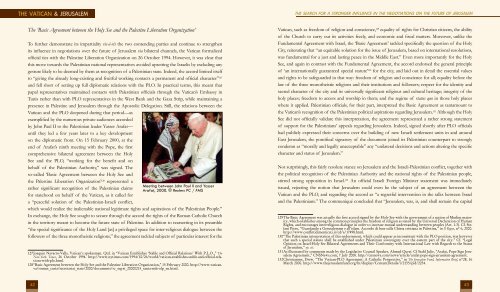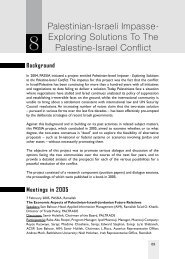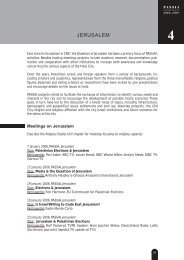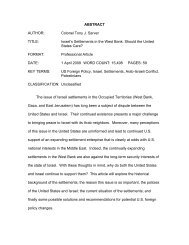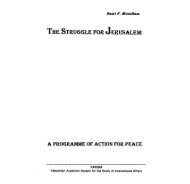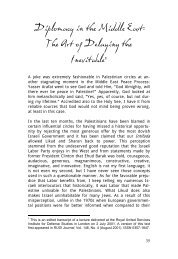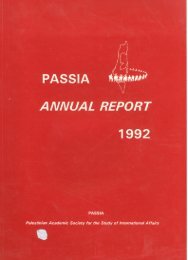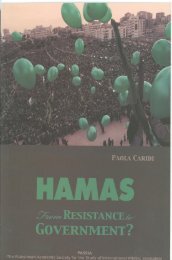The VaTican & Jerusalem - PASSIA Online Store
The VaTican & Jerusalem - PASSIA Online Store
The VaTican & Jerusalem - PASSIA Online Store
You also want an ePaper? Increase the reach of your titles
YUMPU automatically turns print PDFs into web optimized ePapers that Google loves.
<strong>The</strong> Vatican & <strong>Jerusalem</strong><strong>The</strong> Search for a Stronger Influence in the Negotiations on the Future of <strong>Jerusalem</strong><strong>The</strong> ‘Basic Agreement between the Holy See and the Palestine Liberation Organization’To further demonstrate its impartiality vis-à-vis the two contending parties and continue to strengthenits influence in negotiations over the future of <strong>Jerusalem</strong> via bilateral channels, the Vatican formalizedofficial ties with the Palestine Liberation Organization on 26 October 1994. However, it was clear thatthis move towards the Palestinian national representatives avoided upsetting the Israelis by excluding anygesture likely to be deemed by them as recognition of a Palestinian state. Indeed, the accord limited itselfto “giving the already long-existing and fruitful working contacts a permanent and official character” 127and fell short of setting up full diplomatic relations with the PLO. In practical terms, this meant thatpapal representatives maintained contacts with Palestinian officials through the Vatican’s Embassy inTunis rather than with PLO representatives in the West Bank and the Gaza Strip, while maintaining apresence in Palestine and <strong>Jerusalem</strong> through the Apostolic Delegation. Still, the relations between theVatican and the PLO deepened during that period—asexemplified by the numerous private audiences accordedby John Paul II to the Palestinian leader Yasser Arafat—until they led a few years later to a key developmenton the diplomatic front. On 15 February 2000, at theend of Arafat’s ninth meeting with the Pope, the firstcomprehensive bilateral agreement between the HolySee and the PLO, “working for the benefit and onbehalf of the Palestinian Authority,” was signed. <strong>The</strong>so-called ‘Basic Agreement between the Holy See andthe Palestine Liberation Organization’ 128 represented arather significant recognition of the Palestinian claimsfor statehood on behalf of the Vatican, as it called fora “peaceful solution of the Palestinian-Israeli conflict,Meeting between John Paul II and YasserArafat, 2000. © Reuters PC / FMSwhich would realize the inalienable national legitimate rights and aspirations of the Palestinian People.”In exchange, the Holy See sought to secure through the accord the rights of the Roman Catholic Churchin the territory meant to become the future state of Palestine. In addition to reasserting in its preamble“the special significance of the Holy Land [as] a privileged space for inter-religious dialogue between thefollowers of the three monotheistic religions,” the agreement tackled subjects of particular interest for the127 Joaquin Navarro-Valls, Vatican’s spokesman. Qtd. in “Vatican Establishes ‘Stable and Official Relations’ With P.L.O.,” <strong>The</strong>New-York Times, 26 October 1994. http://www.nytimes.com/1994/10/26/world/vatican-establishes-stable-and-official-relations-with-plo.html.128 “Basic Agreement between the Holy See and the Palestine Liberation Organization,” 15 February 2000. http://www.vatican.va/roman_curia/secretariat_state/2000/documents/rc_seg-st_20000215_santa-sede-olp_en.html.Vatican, such as freedom of religion and conscience, 129 equality of rights for Christian citizens, the abilityof the Church to carry out its activities freely, and economic and fiscal matters. Moreover, unlike theFundamental Agreement with Israel, the ‘Basic Agreement’ tackled specifically the question of the HolyCity, reiterating that “an equitable solution for the issue of <strong>Jerusalem</strong>, based on international resolutions,was fundamental for a just and lasting peace in the Middle East.” Even more importantly for the HolySee, and again in contrast with the Fundamental Agreement, the accord endorsed the general principleof ‘an internationally guaranteed special statute’ 130 for the city, and laid out in detail the essential valuesand rights to be safeguarded in that way: freedom of religion and conscience for all; equality before thelaw of the three monotheistic religions and their institutions and followers; respect for the identity andsacred character of the city and its universally significant religious and cultural heritage; integrity of theholy places; freedom to access and worship in them; and the regime of status quo in those holy placeswhere it applied. Palestinian officials, for their part, interpreted the Basic Agreement as tantamount tothe Vatican’s recognition of the Palestinian political aspirations regarding <strong>Jerusalem</strong>. 131 Although the HolySee did not officially validate this interpretation, the agreement represented a rather strong statementof support for the Palestinians’ appeals regarding <strong>Jerusalem</strong>. Indeed, signed shortly after PLO officialshad publicly expressed their concerns over the building of new Israeli settlement units in and aroundEast <strong>Jerusalem</strong>, the pontifical signatory of the document joined its Palestinian counterpart to stronglycondemn as “morally and legally unacceptable” any “unilateral decisions and actions altering the specificcharacter and status of <strong>Jerusalem</strong>.”Not surprisingly, this fairly resolute stance on <strong>Jerusalem</strong> and the Israeli-Palestinian conflict, together withthe political recognition of the Palestinian Authority and the national rights of the Palestinian people,stirred strong opposition in Israel. 132 An official Israeli Foreign Minister statement was immediatelyissued, rejecting the notion that <strong>Jerusalem</strong> could even be the subject of an agreement between theVatican and the PLO, and regarding the accord as “a regretful intervention in the talks between Israeland the Palestinians.” <strong>The</strong> communiqué concluded that “<strong>Jerusalem</strong>, was, is, and shall remain the capital129 <strong>The</strong> Basic Agreement was actually the first accord signed by the Holy See with the government of a nation of Muslim majority,which establishes among the common principles the freedom of religion as stated by the Universal Declaration of HumanRights, and encourages interreligious dialogue in order to increase mutual understanding between peoples (Art. 1-3). Cf. StefaniPiero, “Guardando a Gerusalemme e all’islam. Accordo di base sulla Chiesa cristiana in Palestina,” in Il Regno, n° 6, 2000.http://www.conflittidimenticati.it/cd/a/17498.html.130 “<strong>The</strong> Palestinian interpretation of this endorsement, which could appear as inconsistent with the PLO position, was howeverthat such a special statute shall be established under Palestinian sovereignty over the eastern part of the city.” Cf. “LegalOpinion on Israel-Holy See Bilateral Agreements and <strong>The</strong>ir Conformity with International Law with Regards to the Statusof <strong>Jerusalem</strong>,” op. cit.131 As illustrated by comments made by the Legislative Council Speaker, Ahmed Qurei. Cf Stahl Julie, “Arafat, Pope Sign <strong>Jerusalem</strong>Agreement,” CNSNews.com, 7 July 2008. http://cnsnews.com/news/article/arafat-pope-sign-jerusalem-agreement.132 Christiansen, Drew. “<strong>The</strong> Vatican-PLO Agreement: A Catholic Perspective,” in <strong>The</strong> <strong>Jerusalem</strong> Fund, Information Brief, n°28, 16March 2000. http://www.thejerusalemfund.org/ht/display/ContentDetails/i/2155/pid/2254.42 43


